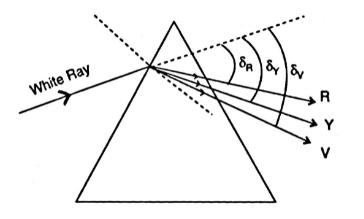
What is the dispersive power of the prism and its SI unit?
Answer
416.7k+ views
Hint:The breaking of white light into its constituent colours is referred to as dispersion. A spectrum is a collection of colours. The separation of different colours of light by refraction is the dispersive power of a transparent medium.
Complete answer:
Initially, the dispersion was examined through a glass prism. It occurs because the refractive index of the medium's substance varies depending on the colour. The term "colours' ' refers to the wavelengths. The ratio of the difference in refractive index of two different wavelengths to the refractive index at some defined intermediate wavelength determines the dispersive power of any transparent medium.

Consider a glass prism as an example; a prism's refractive index is provided by the relationship
Where
The prism formula is as follows:
Because we're talking about small angled prisms,
Therefore,
If
The angular dispersion is known as the difference in deviation between extreme colours.If
On dividing both equation, we get
The expression
The ratio of angular dispersion for any two wavelengths to the deviation of mean wavelength is the dispersive power of a prism's material.The SI unit of dispersive power is
Note:Violet rays have a higher deviation and refractive index than red rays. As a result, violet rays travel at a slower speed through glass than red rays. Yellow rays' refractive index and deviation are used as mean values.
Complete answer:
Initially, the dispersion was examined through a glass prism. It occurs because the refractive index of the medium's substance varies depending on the colour. The term "colours' ' refers to the wavelengths. The ratio of the difference in refractive index of two different wavelengths to the refractive index at some defined intermediate wavelength determines the dispersive power of any transparent medium.

Consider a glass prism as an example; a prism's refractive index is provided by the relationship
Where
The prism formula is as follows:
Because we're talking about small angled prisms,
Therefore,
If
The angular dispersion is known as the difference in deviation between extreme colours.If
On dividing both equation, we get
The expression
The ratio of angular dispersion for any two wavelengths to the deviation of mean wavelength is the dispersive power of a prism's material.The SI unit of dispersive power is
Note:Violet rays have a higher deviation and refractive index than red rays. As a result, violet rays travel at a slower speed through glass than red rays. Yellow rays' refractive index and deviation are used as mean values.
Recently Updated Pages
Master Class 9 General Knowledge: Engaging Questions & Answers for Success

Master Class 9 English: Engaging Questions & Answers for Success

Master Class 9 Science: Engaging Questions & Answers for Success

Master Class 9 Social Science: Engaging Questions & Answers for Success

Master Class 9 Maths: Engaging Questions & Answers for Success

Class 9 Question and Answer - Your Ultimate Solutions Guide

Trending doubts
Give 10 examples of unisexual and bisexual flowers

Draw a labelled sketch of the human eye class 12 physics CBSE

Differentiate between homogeneous and heterogeneous class 12 chemistry CBSE

Differentiate between insitu conservation and exsitu class 12 biology CBSE

What are the major means of transport Explain each class 12 social science CBSE

Why is the cell called the structural and functional class 12 biology CBSE




